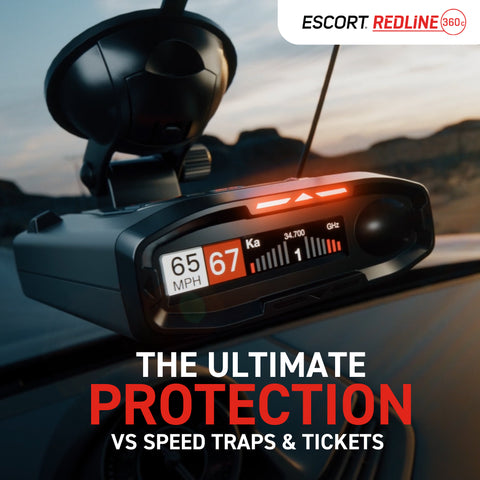What Does X Band Mean on a Radar Detector
Ever wondered, what does X band mean on a radar detector? We've cracked it.
Within this comprehensive guide, we dive deep into the nuances of X Band radar technology, a foundational component of our radar detectors. We'll explore its applications, how it differs from other frequency bands, and why it's essential for everyday driving.
Here at Escort Radar, we can tell you exactly what does vg2 mean on a radar detector, what does MRCD mean on a radar detector, and beyond!
Let's dive into the specifics.
What this article covers:- What Is X Band?
- Applications for X-Band Radar
- Differences Between S and X Band Radar
- Differences Between Ka, K, and X Band Radars
What Is X Band?
X Band refers to a frequency range within the electromagnetic spectrum used in radar technology. Operating typically between 8 and 12 GHz, X Band radars are known for their moderate resolution and range, which make them suitable for a variety of applications, including traffic monitoring and weather observation.
This frequency band is not only prominent in radar speed guns used for vehicular speed monitoring but also in other sectors due to its relatively low atmospheric absorption compared to other higher-frequency bands.
Despite being susceptible to interference from various electronic devices, X Band remains a staple in radar technology due to its balance between range, resolution, and susceptibility to atmospheric conditions.
Applications for X-Band Radar
Our research indicates that X-Band radar has a variety of applications beyond its role in speed monitoring. It's used in maritime navigation for ship radar systems to track other vessels and obstacles in real-time.
In the aviation industry, X-Band radars assist in air traffic control, providing critical information about aircraft positions and weather conditions. Additionally, X Band's moderate resolution makes it suitable for space research and satellite communication.
Differences Between S and X Band Radar
S Band and X Band radars operate at different frequencies, leading to distinct characteristics and applications. S Band, typically between 2 and 4 GHz, offers longer wavelengths, which result in greater penetration through atmospheric conditions, like rain or fog.
Based on our observations, this makes the S Band ideal for moderate-range weather surveillance and ship radar systems.
In contrast, X Band, with its higher frequency, offers finer resolution, which is advantageous for detailed weather observations and short-range speed monitoring. However, its higher frequency also means it has a shorter wavelength, resulting in more susceptibility to atmospheric attenuation compared with S Band.
Differences Between Ka, K, and X Band Radars
Ka, K, and X Band radars each occupy different segments of the electromagnetic spectrum, leading to varying detection ranges and susceptibilities to interference.
Let's begin with what does ka mean on a radar detector. Ka Band, with frequencies typically between 33.4 and 36.0 GHz, offers the highest resolution and is predominantly used for law enforcement speed detection, making it crucial for radar detectors to identify this frequency accurately.
Our findings show that K Band ranges from 18 to 27 GHz and is a common frequency for automotive radar systems, including those used for collision avoidance. K Band offers a balance between range and resolution, making it widely used in both law enforcement and commercial applications.

Best Radar Detectors
At Escort Radar, we understand the importance of staying ahead of evolving radar technologies, including those operating within the X Band frequency. Our radar detectors detect signals across the X Band spectrum, providing drivers with comprehensive protection.
ESCORT Redline 360c
Our radar detectors, like the ESCORT Redline 360c, offer 360° directional awareness and extreme detection range, effectively covering both S and X Band frequencies.
The Redline 360c's 100% true stealth and superior performance across all radar bands, including X Band, provide drivers with the ultimate protection and peace of mind, knowing they are shielded from a wide range of radars.
ESCORT MAX 3
The ESCORT MAX 3 features advanced filtering capabilities specifically designed to distinguish between different radar frequencies, including the X Band. This ensures that drivers receive timely and accurate alerts.
It stands out with its robust internal platform and powerful components, designed to offer unmatched radar detection across all frequencies, including X Band.
The device's improved range and performance make it an indispensable tool for drivers seeking comprehensive detection capabilities on the road.
ESCORT MAX 360c MKII
Escort Radar has developed products like the ESCORT MAX 360c MKII to cater to the varying needs of drivers facing different radar frequencies. This radar detector offers comprehensive coverage and advanced filtering to distinguish between Ka, K, and X Band radars.
Conclusion
We've dissected the intricacies of X Band, showcasing its critical role in modern radar technology and its broader applications beyond the realm of speed detection.
We've also delved into how X Band compares with S, Ka, and K bands, highlighting the unique advantages and considerations of each frequency.
Now that you're armed with this knowledge, visit Escort Radar. Our cutting-edge radar detectors will keep you alert and secure.
If you want to learn more, why not check out these articles below:
- What Does Pop Mean on a Radar Detector
- What Does Laser Mean on a Radar Detector
- How Does a Radar Detector Work?
- How Far Can a Radar Gun Reach
- How to Hide a Radar Detector
- How to Read Radar Detector
- How to Use a Radar Detector
- What Is a Radar Detector
- Do Radar Detectors Work
- Can Police Detect Radar Detectors
- Does Police Radar Work in the Rain
- Does a Radar Detector Have to Be on the Windshield
- What States Are Radar Detectors Illegal
- Are Radar Detectors Legal in California
- Are Radar Detectors Legal in Texas
 |
| 


